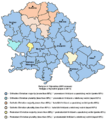Vojvodina facts for kids
The Autonomous Province of Vojvodina (in Serbian: Аутономна Покрајина Војводина or Autonomna Pokrajina Vojvodina) is one of two special regions in Serbia. It is found in the northern part of the country, in a flat area called the Pannonian plain. Its biggest city and capital is Novi Sad. The second largest city is Subotica.
Vojvodina is a very diverse place. It has many different cultures, languages, and ethnic groups. More than 26 different groups live there. Six languages are officially used.
|
|||
|
|||
 |
 |
||
| Official languages | Serbian, Hungarian, Slovak, Romanian, Croatian, Rusyn1 | ||
| Capital | Novi Sad | ||
| Area – Total – % water |
21,500 km² n/a |
||
| Population – Total (2002) – Density |
2,031,992 94.51/km² |
||
| Ethnic groups (2002) |
Serbs: 65.05% Hungarians: 14.28% Slovaks: 2.79% Croats: 2.78% Yugoslavs: 2.45% Montenegrins: 1.75% Romanians: 1.5% Roma: 1.43% Others: 7.97% |
||
| 1 All of the official languages are used in the provincial government, Serbian is used in all municipality governments, others are used in selected municipality governments, and few minority languages are used outside official documents | |||
Contents
Discovering Vojvodina
Vojvodina is a special part of Serbia. It has its own government. This helps it manage its unique culture. It is a land of wide-open spaces.
Where is Vojvodina Located?
Vojvodina is in the northern part of Serbia. It is part of the Pannonian Plain. This is a very flat area. Two big rivers flow through Vojvodina. They are the Danube and the Tisa. These rivers are important for travel and farming.
A Mix of Cultures and Languages
Vojvodina is known for its many different people. Serbs are the largest group. But many Hungarians, Slovaks, Croats, and Romanians also live there. This mix of cultures makes Vojvodina very special. You can hear many languages spoken. You can also see different traditions and foods.
Cities to Explore
The capital city is Novi Sad. It is a lively city on the Danube River. Novi Sad has a famous fortress called Petrovaradin Fortress. This old fortress is a popular place to visit. It also hosts a big music festival every summer.
Subotica is the second largest city. It is known for its beautiful buildings. Many of these buildings are in the Art Nouveau style. This style uses lots of curvy lines and nature designs.
Nature and Outdoors
Vojvodina has beautiful natural areas. Fruška Gora is a national park. It is a low mountain range. You can find many old monasteries there. It is a great place for hiking and enjoying nature. The park is home to many different plants and animals.
There are also many lakes in Vojvodina. Palić lake is one of the most famous. It is a popular spot for relaxing and water sports. The flat landscape is perfect for cycling.
What Does Vojvodina Produce?
Vojvodina is often called "Serbia's breadbasket." This means it produces a lot of food. The flat land and good soil are perfect for farming. Farmers grow crops like wheat, corn, and sunflowers. This region helps feed many people.
A Glimpse into History
Vojvodina has a long and interesting history. It has been part of different empires. These include the Ottoman Empire and the Austro-Hungarian Empire. This long history has shaped its diverse culture. In 1918, Vojvodina joined the Kingdom of Serbia. It became an autonomous province later on. This means it has some power to govern itself.
Images for kids
-
Proclaimed borders of Serbian Vojvodina at the May Assembly (1848) and autonomous Ottoman Principality of Serbia
-
Novi Sad, at the beginning of 20th century
-
National Theatre in Subotica (1852), the second oldest professional theatre in Serbia.
See also
 In Spanish: Voivodina para niños
In Spanish: Voivodina para niños


















